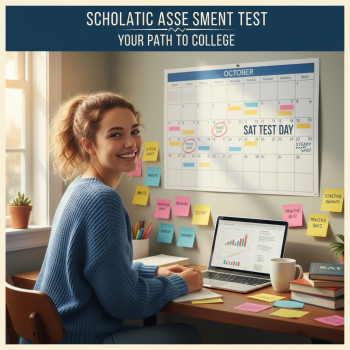Make Holidays Work for You: A Fresh Take on SAT Prep
Holidays arrive like little islands of time in a busy school year — sometimes chaotic, sometimes blissful, always tempting as an excuse to forget about studying. But what if you treated those breaks as strategic windows for real progress on the Digital SAT? When planned well, holiday weeks can be your highest-yield study periods: fewer school commitments, more predictable blocks of free time, and lower day-to-day stress. This post shows you how to design holiday-focused SAT routines that are efficient, balanced, and actually enjoyable — not crammy or exhausting.
Why holidays are ideal for SAT prep (if you do it smart)
First, a reality check: studying during holidays doesn’t mean you should be chained to a desk all day. Done thoughtfully, holiday prep gives you three big advantages:
- Longer uninterrupted blocks: You can complete full practice sections, take a timed practice test, or work through targeted study sessions without last-minute class interruptions.
- Intentional recovery: The right schedule includes rest, which helps memory consolidation. You’ll retain more from a 50-minute focused session with a recovery walk than from a seven-hour burnout day.
- Momentum-building: Focused work streaks across a few holiday days often produce more learning than fragmented weekday attempts.
Quick mental model: quality over quantity
Think of holiday prep like interval training for learning. Short, intense efforts (30–60 minutes) followed by deliberate recovery (walk, hobby, social time) beat marathon sits. The brain learns best when it’s refreshed and able to revisit material multiple times.
Step-by-step: How to map holiday time to SAT goals
Every holiday has a personality: a three-day weekend, a one-week school break, or a two-week winter holiday. Here’s a simple framework to convert that calendar into a study plan that actually improves scores.
Step 1 — Define a clear, small goal for the holiday
Pick one specific outcome. Examples:
- Improve algebraic manipulation speed by practicing 60 mixed math questions and drilling error types.
- Raise reading comprehension stamina by taking two timed Reading sections and analyzing every wrong answer.
- Complete a full digital practice test to simulate test-day routines (device setup, timing, breaks).
Small, measurable goals are easier to hit and easier to repeat across holidays. Don’t promise to “study more”; promise to complete a checklist.
Step 2 — Break the goal into daily micro-tasks
Translate the holiday goal into a daily plan that fits the available time. Example for a one-week break with 3–4 hours/day available:
- Day 1: Baseline timed practice section + review (Reading)
- Day 2: Focused grammar/Essay-style questions + targeted practice (Writing & Language)
- Day 3: Math diagnostic + stop-and-fix of two recurring error types
- Day 4: Full-length practice test (simulated conditions) or Bluebook app practice
- Day 5: Review test mistakes + concept flashcards
- Day 6: Targeted drills + speed work
- Day 7: Light review + planning for the next week
Step 3 — Schedule recovery and fun
Slot at least 25–30% of your available study time for relaxation. This looks like afternoons free for social plans, daily exercise breaks, or device-free time. Ironically, these breaks are part of the productivity plan — they help consolidate learning and prevent burnout.
Designing specific holiday plans by break length
Different breaks demand different approaches. Below are templates you can copy and customize.
Three-day weekend (short and sweet)
Best for: focused skill boosts and test-day rehearsal.
- Day 1 evening: Quick diagnostic (30–40 minutes) to identify one weak spot.
- Day 2 morning: Intense practice session (90 minutes) on that weakness; afternoon off.
- Day 3 morning: Timed section or mixed-practice set + review; finish with a 20-minute reflection and plan.
One-week break (the sweet spot)
Best for: meaningful progress without losing momentum when school resumes.
- Begin with a full diagnostic practice test (not necessarily timed to full length — use it to identify patterns).
- Alternate intensive practice days (Math focus/Reading focus/Writing focus) with light review or strategic rest days.
- Finish with a timed full section or mini-test to measure improvement.
Two-week holiday (deep work)
Best for: skill reconditioning, habit formation, and big jumps.
- Week 1: Diagnostic + focused modules (rotate: algebra, data analysis, rhetorical terms, passage annotation techniques).
- Week 2: Two full practice tests under simulated conditions, in addition to daily short drills. Use test reviews to build a ‘mistake bank’ — the single most valuable artifact from this period.
- Plan a low-cognitive final day: light review and mental prep for returning to school rhythm.
Daily routines that actually stick
Consistency matters more than volume. A sustainable holiday routine should be clear, short, measurable, and pleasant.
Sample daily routine (2–3 hour block)
- 0:00–0:15 — Warm-up (flashcards or one short mixed set)
- 0:15–1:05 — Deep focus block 1 (timed section or targeted practice)
- 1:05–1:30 — Active review (explain mistakes, note patterns)
- 1:30–1:50 — Break (walk, snack, non-screen)
- 1:50–2:30 — Focus block 2 (skill drilling or strategy work)
- 2:30–2:45 — Reflection and next-day planning
Adjust blocks based on your concentration rhythm. If you work better in short bursts, swap to 4 × 30-minute focused sessions.
How to choose practice tests and materials during holidays
Quality resources and realistic practice are the backbone of holiday prep. For the digital SAT era, simulated test experiences are especially important: device setup, timing, and the digital interface can change how you approach passages and math problems.
- Official digital practice: Use realistic digital sims for at least one full test per long break. Simulate the full experience: device, Bluebook app behavior, and timed conditions.
- Targeted question sets: After identifying recurring error types, drill those exact problems with mixed timing to mimic unpredictability.
- Active review tools: Build a mistake log and categorize errors into concept gaps, careless mistakes, vocabulary issues, and time-management problems.
Table: Holiday practice blueprint (one-week example)
| Day | Primary Focus | Study Activities | Time Estimate |
|---|---|---|---|
| Day 1 | Diagnostic & Planning | Baseline digital section; create mistake bank; set holiday goal | 2–3 hrs |
| Day 2 | Math (Algebra) | Targeted drills; timed problem sets; review | 2–3 hrs |
| Day 3 | Reading | Timed passage practice; annotating strategies; review | 2–3 hrs |
| Day 4 | Writing & Language | Grammar drills; syntax and logic questions; error analysis | 1.5–2.5 hrs |
| Day 5 | Full Practice Test | Take digital practice test under simulated conditions | 3–4 hrs |
| Day 6 | Review Test Mistakes | Deep error analysis; targeted re-drills from mistake bank | 2 hrs |
| Day 7 | Consolidation & Planning | Light review, flashcards, plan for next week | 1–1.5 hrs |
Smart tactics to use during your holiday study
Here are evidence-backed tactics that elevate what you do in those study blocks.
1. Interleaving beats single-skill marathons
Mix math, reading, and writing practice in a single day rather than spending the whole day on one topic. Interleaving helps your brain discriminate problem types and apply strategies more flexibly.
2. Practice with the clock — but prioritize deliberate review
Timing simulates test pressure, but it’s the post-test analysis — understanding why each wrong answer happened — that produces learning. After any timed section, spend at least 30–50% of the time reviewing mistakes.
3. Build a mistake bank and keep it alive
Record every error: what the question tested, your thinking, the correct approach, and the root cause. During later holidays, your mistake bank becomes a short, high-impact curriculum focused on your actual weaknesses.
4. Use active recall and spaced repetition
Flashcards (digital or physical) are powerful. Make cards that ask you to explain a concept, not just recall definitions. Revisit them on a spaced schedule: immediate review, one-day delay, three-day delay, one-week delay.
5. Simulate test day at least once per long holiday
Dress comfortably, use your testing device exactly as you will on test day, follow the timing script, and include breaks. This reduces surprises and builds psychological readiness.
Balancing family, travel, and prep — practical strategies
Holidays often mean family gatherings, travel, or odd schedules. Here’s how to keep momentum without being a study hermit.
- Create a visible but flexible schedule: Post a short checklist each day that family members can see so they know your study windows.
- Travel-friendly practice: Pack short warm-up sets and digital flashcards for transit time. Use offline practice when internet is spotty.
- Involve others: Ask a family member to help time practice tests or hold you accountable for your morning session.
- Protect one social night a week: Social recovery is part of the plan — it keeps motivation high.
When to bring in a tutor (and how Sparkl’s personalized tutoring fits naturally)
Holidays are a great time to work with a tutor because you have larger uninterrupted blocks and clearer short-term goals. Consider tutoring if any of the following apply:
- You’re making the same mistakes despite repeated practice.
- You’re stuck on a concept that’s blocking multiple question types (e.g., function interpretation, evidence-based reading).
- You want a personalized study plan that turns a two-week break into a measurable score jump.
Sparkl’s personalized tutoring can be particularly useful during holidays: 1-on-1 guidance helps you turn a broad holiday plan into an individualized daily checklist; tailored study plans make every hour count; expert tutors can diagnose patterns faster than solo study; and AI-driven insights can help prioritize what to fix first. If you book targeted sessions during a break, you can emerge from the holiday with clear progress and confidence rather than vague intentions.
Motivation and mindset during holidays
Staying motivated through a break is easier when progress is visible. Use these tips to keep morale high:
- Track small wins: Celebrate clearing a conceptual hurdle, shaving 10 minutes off timing, or scoring higher on a practice section.
- Reward structure: Pair study achievements with non-study rewards — a movie night, a small outing, or a special meal.
- Accountability check-ins: Use a study buddy, teacher, or tutor to check progress mid-holiday.
Real-world example: How one student used spring break to improve 80 points
Meet Maya (a composite example drawing on typical student stories). Maya had a baseline SAT practice test she took the weekend before spring break. She scored consistently but noticed a pattern: careless mistakes in algebra and weak passage mapping in Reading.
Her spring break plan (7 days) looked like this:
- Days 1–2: Math bootcamp — error bank review and 60 targeted algebra problems each day.
- Day 3: Reading strategy day — practice with paraphrasing and passage maps, plus two timed reading sections.
- Day 4: Full digital practice test to measure improvement.
- Days 5–6: Mixed review based on practice test mistakes.
- Day 7: Light review and planning for a follow-up tutor session.
She used short, frequent breaks and tracked errors. After the break, her practice test score rose about 80 points. The real change wasn’t magic; it was a focused, measurable plan, an active mistake bank, and a few targeted tutoring sessions that corrected persistent misconceptions. The rest of the school term she kept revisiting the mistake bank between classes.

Common holiday pitfalls and how to avoid them
- Pitfall: All-or-nothing thinking. Avoid planning to study for eight hours every day. Instead, aim for consistent, smaller wins.
- Pitfall: Ignoring sleep. Sleep is non-negotiable. Memory consolidation happens while you rest.
- Pitfall: Passive re-reading. Flashcards, practice problems, and error analysis beat endless re-reading of notes.
- Pitfall: No test-day simulation. Skipping a realistic practice test means you won’t know how pacing and digital setup affect performance.
Measuring progress: what to track over the holiday
Track these simple metrics to evaluate whether your holiday made a difference:
- Percent correct on timed sections (Math, Reading, Writing).
- Types and frequency of mistakes from the mistake bank.
- Time per question averages for each section.
- Number of full or partial practice tests completed under simulated conditions.
Mini data tracker (example entries)
| Metric | Before Holiday | After Holiday | Notes |
|---|---|---|---|
| Math timed section accuracy | 62% | 71% | Fewer careless errors after focused drills |
| Reading timed section accuracy | 60% | 66% | Better passage mapping reduced wasted rereading |
| Number of practice tests | 1/month | 2 during holiday | Simulated tests improved pacing |
Putting it together: a sample two-week holiday plan (copyable)
Use this template and personalize it. It balances intensity with rest and includes measurable checkpoints.
- Day 1: Full diagnostic (untimed if you prefer) + set 2 holiday goals.
- Day 2: Math — focused drills + 30 minutes of flashcards.
- Day 3: Reading — 2 timed passages + review.
- Day 4: Writing — grammar drills + rhetorical strategy practice.
- Day 5: Light review & active rest (exercise, hobby).
- Day 6: Full digital practice test (simulate test day).
- Day 7: Deep review of test errors + create targeted problem sets.
- Day 8: Math — complex problem-solving and timed sets.
- Day 9: Reading — focus on inference and evidence-based questions.
- Day 10: Writing — practice mixed sets and time-management drills.
- Day 11: Targeted re-drills from your mistake bank.
- Day 12: Full practice section under timed conditions + review.
- Day 13: Light review, flashcards, and a short practice set.
- Day 14: Reflection, review progress metrics, and schedule follow-up practice/tutor sessions.
Final thoughts: Holidays are an advantage — use them well
Holidays are not magic; they’re opportunity. With the right mindset, a strategic plan, and a few smart tools — including occasional personalized tutoring — you can turn time off from school into time forward for your SAT goals. Keep your goals measurable, mix focused practice with solid rest, and use at least one simulated digital test during longer breaks to reduce surprises on test day. If you find yourself repeating the same errors or want a holiday plan that’s laser-focused on your weaknesses, consider booking a targeted session with a tutor. Personalized guidance transforms a good study plan into a great one, and a few well-placed sessions can multiply the returns of your holiday effort.
Go into your next holiday with a plan that respects your need for rest and your goal for growth. When you return to school, you won’t just have memories of a break — you’ll have measurable progress, more confidence, and a clearer path to the score you want.
Ready to try a holiday plan?
Start small: pick one upcoming holiday, set a single clear goal, and try the one-week blueprint. Track your wins, adjust as needed, and remember — steady progress beats last-minute drama. Good luck, and happy studying!
















No Comments
Leave a comment Cancel